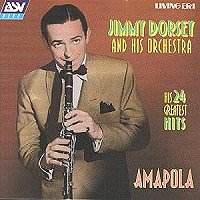Collection: Paul Whiteman and his Orchestra -
Say it with Music
 ASV Living Era CD AJA5291
Mono
ASV Living Era CD AJA5291
Mono
Collection: Jimmy Dorsey and his Orchestra
-
Amapola
 ASV Living Era CD AJA
5287 mono
ASV Living Era CD AJA
5287 mono
Collection: Paul Whiteman and his Orchestra - Say it with
Music
1. The Japanese Sandman
2. My Mammy.
3. Cherie
4. Say it with Music
5. Stumbling.
6. Hot Lips.
7. Parade of the Wooden Soldiers.
8. Linger Awhile. |
9. What'll I Do.
10. Somebody Loves Me.
11. Valencia.
12. The Birth of the Blues.
13. In a little Spanish Town.
14. My Blue Heaven.
15. Among my Souvenirs .
16. Ramona. |
17. Ol' Man River
18. Together.
19. My Angel.
20. Great Day.
21. Body and Soul.
22. All of Me.
23 Smoke Gets in Your Eyes |
Collection: Jimmy Dorsey and his Orchestra
- Amapola
1. I'm an Old Cow Hand.
2. Never in a Million Years.
3. Too Marvellous for Words.
4. I Fall in love with you Everyday.
5. Change Partners.
6. Hold Tight Hold Tight.
7. Deep Purple.
8. Six Lessons from Madam La Zonga. |
9. The Breeze and I.
10. I Hear a Rhapsody.
11. High on a Windy Hill.
12. Amapola.
13. Yours.
14. My Sister and I.
15. Maria Elena.
16. Green Eyes. |
17. Blue Champagne.
18. Jim.
19. Tangerine.
20. My Devotion.
21. Besame mucho.
22. Star Eyes.
23. They're Either Too Young or Too Old.
24. When they ask about you. |
I have chosen to cover these two records in one review because together they
contain typical music from Big Bands in the era 1920 to 1943, some 23 years.
Paul Whiteman from 1920 to 1933 and Jimmy Dorsey from 1936 to 1943. From
a social history point of view, probably even more importantly, they represent
popular music of that era. All the tracks on both records were hit recordings
and so if television had been invented somewhat earlier, we are hearing what
would have been on" Top of the Pops" in those days!
The production of both albums was carried out by the same team, transcriptions
from the original 78's by Peter Dempsey and David Lennick, whilst audio
restoration and remastering was carried out by Martin Haskell and Tim Debney.
They have done a really excellent job, because these tracks are not marred
by any of the scratch and hiss that were the bugbear of the 78 rpm recording.
Paul Whiteman employed many of the famous jazz musicians of the time including
Bix Beiderbecke, Bunny Berigan, Tommy Dorsey, Jimmy Dorsey, Frankie Trumbauer
and Eddie Lang. Little is heard of their improvising ability however and
it was probably the prospect of regular work that attracted them, more than
the musical experience! Despite this Paul Whiteman played an important part
in the history of both Big Bands and popular music in general, to the many
fans of the music of the 20's and 30's this represents a musical feast.
The Dorsey brothers Tommy and Jimmy seem to have spent most of their lives
in disagreement, only coming together occasionally with the Dorsey Brothers
Orchestra. They seem to have been of a remarkably different temperament,
though each was an excellent musician. Tommy was a disciplinarian whereas
Jimmy was easy going and humorous. The tracks on the CD are mostly of tunes
which are still frequently heard to-day, Bing Crosby is the vocalist on the
first three tracks and it is easy to see why they were so popular. All of
the tracks have vocals and the remainder are shared between Bob Eberly, Helen
O'Connell and Kitty Kallen, who were the bands regular vocalists at the time.
The Andrews Sisters make a surprise appearance on track 6.
In reviewing these albums it is noticeable, as to how the rhythm sections
gradually move from the plodding sounds of the early 20's, toward the looser
sounds of the 40's a trend which has continued up to to-day. These albums
represent two unique pieces of history in the development of Popular Music
and the Big Band, the standard of musicianship throughout, is such that there
is little doubt that Paul Whiteman and Jimmy Dorsey employed the best musicians
that were around at the time.
Both albums are worthy of three stars.
Reviewer
Don Mather




